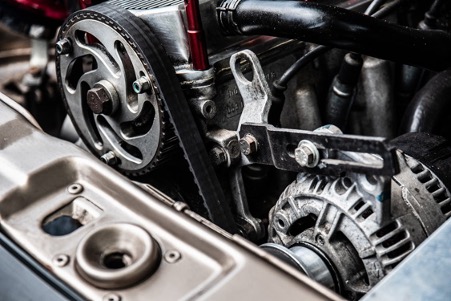The timing belt is an essential component of your car. You’ll want to have it replace whenever necessary, ideally before it fails and causes damage to your engine. Here are some of the signs you need to look out for if your timing belt is bad and needs to be replaced.

8 Signs Your Timing Belt Is Going Bad
1. Your Engine Is Misfiring
The most crucial role of the timing belt is keeping the cylinders in sync. If the timing belt starts to have problems, the cylinders can get out of sync. This causes the engine to begin misfiring. Another sign is that you aren’t getting the same performance from the car. This is one of the biggest warning signs. It can’t be ignored, as it means that you are starting to damage your engine.
2. You Hear A Ticking Noise From Your Engine
The timing belt is connected to pulleys in the crankshaft. When it has started to wear out, it won’t be able to turn the pulleys properly. This is what produces the ticking sound. However, ticking can also be caused by a low level of oil in the engine. Either way, it’s a serious issue, so make sure that it gets checked out by a mechanic.

3. Oil Is Leaking From Your Motor
The timing belt is held in place by a series of nuts. However, over time, these can loosen. When this happens, it can cause an oil leak around the timing belt cover. As you can imagine, this can be a serious problem. When the flow of oil is disrupted, there is a big risk that the engine might overheat. If this happens, it can lead to significant damage and a big repair bill.
4. You Have Smoke Coming From Your Exhaust
If you notice more smoke coming out of your exhaust than normal, this can be a sign that you are forcing the engine to work harder than usual. However, it can also be a sign of other engine problems. For example, it could be a sign that fluid is leaking and the engine is burning oil. It could also be a problem with the filters, limiting the amount of air that is getting to the engine.
5. If You Notice A Change In Your RPMs (Revolutions Per Minute)
The number of revolutions per minute (RPM) is on the dashboard. This number is a way of determining how hard the engine is working. Manual drivers will use it to decide when to change up a gear. If something is wrong with the timing belt, like it’s missing teeth, it can cause the RPM to act erratically.

6. You Are Unable to Start the Engine
One of the most obvious signs that there is something wrong is when you are unable to start the engine. If this is happening, it could be a sign that the timing belt is completely broken. You should be able to hear the starter clicking. But because the belt is responsible for the crankshaft, the car won’t start.
7. It’s Been 60,000+ Miles (or 5 Years) Since Your Timing Belt Was Last Replaced
It’s best not to wait until any of these signs start to appear. It’s a good idea to keep records of when you last had parts replaced. While they will have mileage specifications on the belt, it’s best to go by how long it has been in the engine. Every five to six years, you should aim to replace the belts. However, this can change, depending on how often you use the vehicle.
8. Your Check Engine Light Is On
Depending on what car your drive, a problem with your timing belt might activate the check engine light. Though it’s one of the least dramatic warning signs, this light should never be ignored. It means that there is something wrong, and you should contact a mechanic as soon as possible.
The Importance Of The Timing Belt
The timing belt is a critical engine component. It helps to keep the camshaft and the crankshaft in sync. This ensures that the cylinders are firing at the right time. It can be found under the timing belt cover at the front of the engine.
It should be noted that not all cars have a timing belt. Some of the more modern engines will come with a timing chain. As long as you are getting oil and fluid changes, this type of belt should last forever.
Rubber timing belts are built to last, made from strong rubber. However, if you have had it for a long time, it can start to wear down. The belt is subject to high temperatures and constant friction. If left for long enough, it will eventually crack. When this happens, it will need to be replaced. Here are some of the symptoms to look out for.
What To Do If Your Timing Belt Breaks While Driving
It can be very dramatic if the timing belt breaks while you are driving. The crankshaft will completely stop turning. How serious the damage ends up being will depend on many factors like the type of car you are driving. When this happens, it is impossible to deny that you are having engine problems!
If you are driving a non-interference engine, you will avoid the worst of the damage. The car will stall, and you won’t be able to get the engine to start again. The good news is that the pistons and valves won’t be damaged.
However, if you are driving an interference engine, you will be in for a more extensive repair bill. Some of the valves will be left in the open position. The momentum of the crankshaft will keep it moving. As a result, the pistons will be driven into the valves. As you can imagine, this does a lot of damage to the engine. It can bend the valve and damage the piston head. In some cases, the whole cylinder block can be damaged. This will lead to a costly repair.
Replacing a Timing Belt
You can try to replace the timing belt yourself, but this can be a complex procedure. It’s best to contact your local mechanic. Once you bring in your car, they will examine the engine. This will give them a good idea of how bad the timing belt is. They will also want to examine the surrounding parts, like the pistons and valves, to evaluate their condition.
Then, they will need to fit the new timing belt. They might want to replace a few other elements around the timing belt. For example, it might be necessary to change the water pump, belt tensioner, or pulleys.
Finally, the mechanic will need to synchronize the engine. This ensures that the pistons are in the right place. This can be a delicate process, so make sure you take your vehicle to a trusted mechanic.
Usually, it will take around three to six hours to replace the timing belt. However, the mechanic may need to order specific parts. It can take a few weeks for them to arrive.
How much replacing a timing belt costs can vary. If you are replacing the timing belt before it breaks, it can cost upwards of $500. However, this bill will quickly grow if you need to fix damage caused by a broken or bad timing belt.
Final Thoughts
The timing belt has a crucial role to play in the functioning of your car engine. If you have had it for over six years, you should consider making an appointment with your mechanic to replace it. While this might be an expensive procedure, it can save you from future engine damage and headaches.
If you are experiencing any of these issues, book an appointment with SL Autoworks in Maumelle, AR, today! Remember, the longer you ignore these problems, the worse it will get, and the more expensive it will be to repair.



